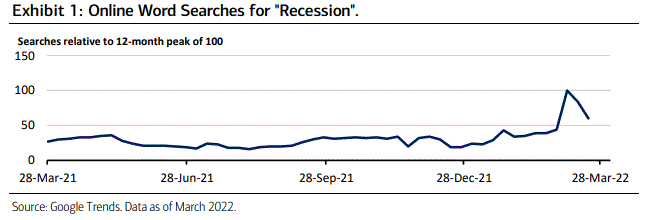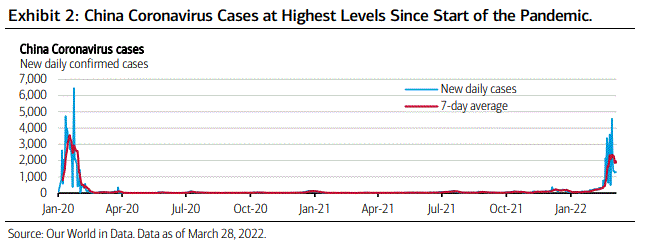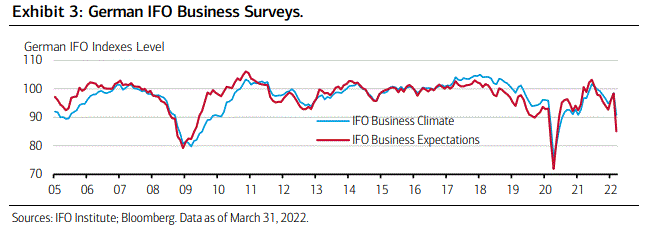Verden er på tynd is – og med verden mener Merrill de tre største økonomier: USA, Kina og Europa, der står for 65 pct. af verdens BNP. Merrill betegner udfordringen for de tre med bogstavskombinationen I.C.E., nemlig Inflationen for USA, Coronaen for Kina og Energien for Europa. Foreløbig er der ikke nogen risiko for aktiemarkederne, men det kan ændre sig. Inflationen stiger i USA som overalt, og det kan føre til recession. Corona-udbruddet i Kina kan svække den dynamiske kraft, som Kina har, og dermed svække den globale økonomiske genopretning efter pandemien. Krigen i Ukraine giver en enorm energi-udfordring for Europa, og det kan påvirke de europæiske virksomheders investeringer i USA og de amerikanske virksomheders globale indtjening. Der er ikke noget, der hedder “splendid isolation”, skriver Merrill. Verden hænger sammen trods nok så megen snak om, at globalseringen rulles tilbage. Derfor står verden ikke på fast grund, men på tynd is.
The Big Three Are On Thin I.C.E.
We remain constructive on U.S. Equities but believe the choppy and volatile nature of the markets
in Q1 will be on display again in Q2. This, despite the fact that the markets have priced in a number
of negative variables—aka, the Ukraine/Russia conflict, a spike in global oil prices, and a more
hawkish Fed.
Our more guarded outlook is based on the belief that the world’s “Big Three” confront some
significant near-term challenges, and how these challenges are met, or not, will dictate the nearterm
trajectory of asset prices.
Who are the “Big Three”? Think the U.S., European Union and China,
whose combined economic output accounts for roughly 65% of world gross domestic product
(GDP) (based in nominal U.S. dollars). As this trio goes, so goes nearly everything global: real
growth, trade, investment, credit, earnings and relative asset prices.
The challenges for the “Big Three”? Think I.C. E.—or higher-for-longer Inflation in the U.S., soaring
coronavirus cases in China and the energy shock in Europe.
I=Inflation and the U.S. The good news: The U.S. is shifting from a pandemic to an endemic
phase and faces nominal risks from the conflict with Ukraine/Russia. The bad news: Inflationary
pressures and price expectations have yet to peak in the U.S. Inflation is expected to remain
persistently higher for longer, meaning a more hawkish stance from the Fed in terms of raising
the fed funds rate and reducing the Fed’s balance sheet. The odds now favor a 50 bps hike in the
fed funds rate in May.
How fast and far the Fed will need to go in re-anchoring inflation and inflation expectations
remains unclear. Less hazy: The risks of a U.S. recession are rising, with the economic term
increasingly creeping into the narrative of the markets (Exhibit 1). That said, slower-than-expected
real GDP growth—not a recession—is our operating base case for U.S. over the next 12 to 18
months.
In the face of a hawkish Fed are numerous growth tailwinds: the fading pandemic; a flush
consumer with some $2 trillion in excess savings, according to Bureau of Economic Analysis.; the
need for massive inventory rebuilding; well-capitalized Corporate America; and the lagged effects
of the massive monetary stimulus of the past two years (according to Evercore ISI Research, M2
has increased 41% over the past two years).

In addition to the above, it is worth remembering that U.S. Equities typically move higher at the
beginning of a Fed tightening cycle owing to stronger nominal growth and rising pricing power—
twin engines of earnings growth.
C= Coronavirus and China. It’s back to the future in China, with both Shanghai, the financial hub
of China, and Shenzhen, the nation’s tech hub, partially shut down last month, reviving images of a
world shutter in place two years ago when the pandemic first emerged. As of late March, over 70
major cities in China were either in partial or full shutdown mode.3 As Exhibit 2 illustrates, China’s
zero-Covid policies are falling short, with the number of new daily cases in China among the
highest since the pandemic began.
More shutdowns, not unexpectedly, means more downside risks to China’s growth outlook.
Service activities (travel, retail, etc.) will bear the brunt of the shutdowns and dampen Chinese
personal consumption levels. Manufacturing remains a priority for a government still expecting
the economy to expand 5.5% this year. That might be a stretch. Factories are running, and ports
are open, but delays have been reported in getting product into and out of warehouses due to
driver shortages, warehouse closings and other issues in the supply chain.
Reflecting these
bottlenecks, China’s manufacturing purchasing managers’ index (PMI) fell to 49.5 in March, down
from 50.2 in February. The official March composite PMI, which aggregates both manufacturing
and service activities, fell to 48.8 in March from 51.2 the month prior, the weakest reading since
February 2020, when the pandemic began.

The bottom line: The last thing a fragile global economy needs right now—one struggling to
overcome insufficient supplies across a spectrum of products—are supply-side disruptions in the
world’s largest exporter.
E=Energy shock and Europe. Not for the first time, nor the last time, Europe has emerged as the
weak link of the global economy. Proximity to the conflict with Ukraine/Russia, and Europe’s
energy dependence on Russian oil and gas, have hobbled one of the key pillars of the world
economy. Inflation in Europe’s largest economy, Germany, spiked to a 30-year high in March, to
7.3%, owing largely to soaring energy costs. The latter has sapped both business and consumer
confidence (Exhibit 3), and could tip Germany and many other parts of Europe into recession.

Rising prices and failing growth prospects leave the European Central Bank in a policy bind—
namely, raising interest rates in the near term to combat inflation risks exacerbating the unfolding
economic slowdown. Some fiscal supplemental spending is expected from Brussels and other
individual nations, but easier fiscal policies will come too little, too late to offset Europe’s energy
induced economic slowdown/recession.
There is no such thing as splendid isolation. On a standalone basis, rarely have the policy
challenges confronting the U.S., Europe and China been as stark as today. The U.S. needs to
contain inflation; China needs to conquer coronavirus and Europe needs to counter the spike in
energy costs.
How and whether they succeed matters since whatever transpires in each of the
“Big Three” doesn’t stay there. To wit, a Fed-induced hard landing in the U.S. would put China’s
export machine at risk and undermine Corporate Europe’s massive investment position in the
U.S.. Coronavirus-related shutdowns in China will delay the healing of global supply chain woes
and add more fuel to global inflationary fires. And the more Europe spirals downward, the greater
the risks to the global earnings of U.S. multinationals that count Europe as their top market in
terms of non-U.S. earnings.
Add it all up, the world is on thin I.C.E. as the second quarter begins




